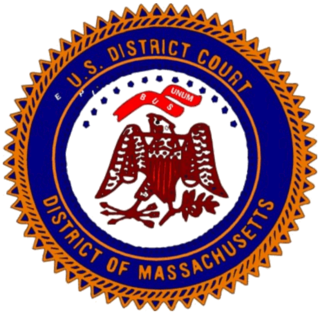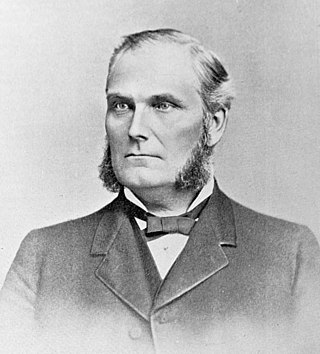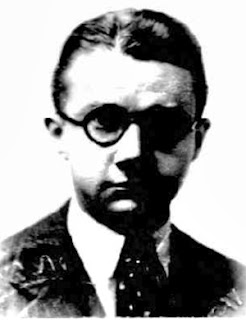
The Alexander Hamilton U.S. Custom House is a government building, museum, and former custom house at 1 Bowling Green, near the southern end of Manhattan in New York City, New York, United States. Designed by Cass Gilbert in the Beaux-Arts style, it was erected from 1902 to 1907 by the government of the United States as a headquarters for the Port of New York's duty collection operations. The building contains the George Gustav Heye Center museum, the United States Bankruptcy Court for the Southern District of New York, and the New York regional offices of the National Archives. The facade and part of the interior are New York City designated landmarks, and the building is listed on both the New York State Register of Historic Places and the National Register of Historic Places (NRHP) as a National Historic Landmark. It is also a contributing property to the Wall Street Historic District, listed on the NRHP.

Harlan Fiske Stone was an American attorney and jurist who served as an associate justice of the U.S. Supreme Court from 1925 to 1941 and then as the 12th chief justice of the United States from 1941 until his death in 1946. He also served as the U.S. Attorney General from 1924 to 1925 under President Calvin Coolidge, with whom he had attended Amherst College as a young man. His most famous dictum was: "Courts are not the only agency of government that must be assumed to have capacity to govern."

Riverside Drive is a scenic north–south thoroughfare in the New York City borough of Manhattan. The road runs on the Upper West Side of Manhattan, generally paralleling the Hudson River and Riverside Park between 72nd Street and the vicinity of the George Washington Bridge at 181st Street. North of 96th Street, Riverside Drive is a wide divided boulevard. At several locations, a serpentine local street diverges from the main road, providing access to the residential buildings. Some of the city's most coveted addresses are located along its route.

Rufus W. Peckham was an American lawyer and jurist who served as an Associate Justice of the U.S. Supreme Court from 1895 to 1909, and is the most recent Democratic nominee approved by a Republican-majority Senate. He was known for his strong use of substantive due process to invalidate regulations of business and property. Peckham's namesake father was also a lawyer and judge, and a U.S. Representative. His older brother, Wheeler Hazard Peckham (1833–1905), was one of the lawyers who prosecuted William M. Tweed and a failed nominee to the Supreme Court.

The United States District Court for the District of Massachusetts is the federal district court whose territorial jurisdiction is the Commonwealth of Massachusetts, United States. The first court session was held in Boston in 1789. The second term was held in Salem in 1790 and court session locations alternated between the two cities until 1813. That year, Boston became the court's permanent home. A western division was opened in Springfield in 1979 and a central division was opened in Worcester in 1987. The court's main building is the John Joseph Moakley Federal Courthouse on Fan Pier in South Boston.

Castle Clinton is a restored circular sandstone fort within Battery Park at the southern end of Manhattan in New York City. Built from 1808 to 1811, it was the first American immigration station, predating Ellis Island. More than 7.5 million people arrived in the United States at Fort Clinton between 1855 and 1890. Over its active life, it has also functioned as a beer garden, exhibition hall, theater, and public aquarium. The structure is a New York City designated landmark and a United States national monument, and it is listed on the National Register of Historic Places.

The Roosevelt Hotel is a former hotel at 45 East 45th Street in the Midtown Manhattan neighborhood of New York City. Named in honor of U.S. president Theodore Roosevelt, the hotel was developed by the New York Central Railroad and the New York, New Haven and Hartford Railroad and opened in 1924. The 19-story structure was designed by George B. Post & Son with an Italian Renaissance Revival-style facade, as well as interiors that resembled historical American buildings. The Roosevelt Hotel is one of several large hotels developed around Grand Central Terminal as part of Terminal City.

Horace Henry Powers was an American lawyer, judge and politician. He was most notable for his service as an Associate Justice of the Vermont Supreme Court and a U.S. Representative from Vermont (1891-1901).
The New York City Law Department, also known as the Office of the Corporation Counsel, is the department of the government of New York City responsible for most of the city's legal affairs. The department is headed by the Corporation Counsel, currently Sylvia Hinds-Radix, the 81st official to hold this position.

Pliny T. Merrick was an American attorney and politician from Massachusetts. He served as an associate justice of the Massachusetts Supreme Judicial Court.

Wade Hampton Ellis was a Republican politician in the U.S. state of Ohio who served as Ohio Attorney General (1904–1908), then Special Assistant to the Attorney General of the United States (1909–1911) and special counsel to the U.S. Department of Justice where he gained fame as a trust buster before resuming a private practice. The United States Supreme Court also appointed Ellis as special master in the case of Massachusetts v. New York. While splitting his time between Washington, D.C., and Cincinnati, Ohio, Ellis acquired and restored Rippon Lodge, which proved to be built by his ancestors and which a descendant placed on the National Register for Historic Places

The Lexington Hotel, Autograph Collection is a hotel at 509 Lexington Avenue, at the southeast corner with 48th Street, in the Midtown Manhattan neighborhood of New York City. The 27-story hotel was designed by Schultze & Weaver in the Romanesque Revival style and contains 725 rooms. The Lexington, one of several large hotels developed around Grand Central Terminal as part of Terminal City, is a New York City designated landmark.

Daniel Sachs Goldman is an American attorney, politician, and heir, who is the member of the U.S. House of Representatives from New York's 10th congressional district. A member of the Democratic Party, he previously served as lead majority counsel in the first impeachment inquiry against Donald Trump and lead counsel to House Managers in Trump's subsequent impeachment trial. Goldman is among the wealthiest members of Congress, with an estimated personal net worth of up to $253 million according to financial disclosure forms.

William Andrew Sutherland was an American lawyer and politician from New York.

Charles Francis Brown was an American lawyer and judge from New York.
John Thomas Norton was an American lawyer and politician from New York.
William Newcorn was a Polish-born Jewish-American lawyer, politician, and judge from New Jersey.
Ernest Hall was an English-born American lawyer and judge from New York.

W.E. Hill was an American cartoonist and illustrator active in the first half of the 20th-century. He is best known for his weekly full-page illustration series "Among Us Mortals" published in the New York Tribune from 1916 to 1922, and for creating the most popular iteration of the optical illusion My Wife and My Mother-in-Law (1915).

















